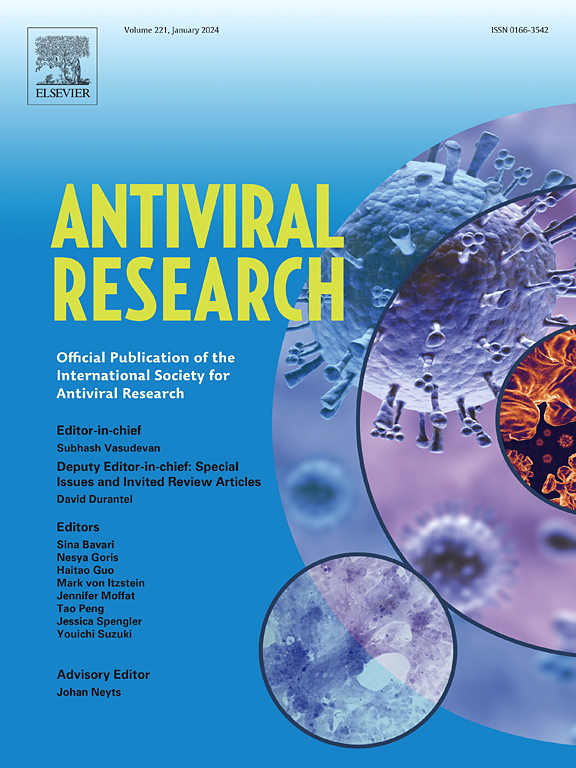LAVR-289, a broad-spectrum antiviral, protects immunosuppressed Syrian hamsters against lethal adenovirus challenge
IF 4.5
2区 医学
Q1 PHARMACOLOGY & PHARMACY
引用次数: 0
Abstract
LAVR-289, a newly described acyclic nucleoside phosphonate prodrug, has previously shown in vitro efficacy against adenovirus (HAdV) species B, C, D, E, and F with EC50 values of 100 nM to 1.2 μM. The compound was efficacious prophylactically against systemic HAdV infection in immunosuppressed Syrian hamsters. Here, we present further, more detailed data on its efficacy against HAdV. We tested the two enantiomers at chiral phosphorus center (Sp and Rp) of LAVR-289 and found that both stereoisomers were equally efficacious against HAdV-C5 and -C6 infecting human foreskin fibroblast primary cells in vitro, indicating that the racemic mixture of the compound could be used as a drug. Following these favorable in vitro results, the antiviral activity of racemic LAVR-289 was evaluated in the immunosuppressed Syrian hamster model, in which the hamsters were challenged with the intravenous LD90 dose of HAdV-C6. Prophylactic administration of LAVR-289 completely prevented mortality at doses of 24 mg/kg p.o. q.d. or higher. At the efficacious dose levels, it significantly inhibited virus replication in the liver and mitigated HAdV-C6-induced liver damage. As prophylactic administration may not be advisable in a clinical setting, we delayed the administration of LAVR-289 and showed that the compound prevented mortality and significantly reduced morbidity even when the drug was withheld for 3 days post challenge. Based on these results, we believe that these data demonstrate in vitro and in vivo potency of LAVR-289 against HAdVs and support its continued development.
LAVR-289是一种广谱抗病毒药物,可保护免疫抑制的叙利亚仓鼠免受致命腺病毒的攻击
LAVR-289是一种新发现的无环膦酸核苷前药,先前在体外对腺病毒(hav) B、C、D、E和F有抑制作用,EC50值为100 nM ~ 1.2 μM。该化合物对免疫抑制的叙利亚仓鼠全身hav感染有有效的预防作用。在这里,我们提供了进一步的、更详细的数据,说明其对hav的疗效。我们在体外对LAVR-289的手性磷中心(Sp和Rp)的两个对映体进行了测试,发现这两个对映体对感染人包皮成纤维原代细胞的HAdV-C5和-C6具有相同的疗效,表明该化合物的外消旋混合物可作为药物使用。在这些有利的体外结果之后,外消旋LAVR-289的抗病毒活性在免疫抑制的叙利亚仓鼠模型中进行了评估,在该模型中,仓鼠静脉注射LD90剂量的HAdV-C6。在每日每日24毫克/公斤或更高剂量下,预防性给药LAVR-289完全预防死亡。在有效剂量水平下,它能显著抑制病毒在肝脏中的复制,减轻hadv - c6诱导的肝损伤。由于预防性给药在临床环境中可能不可取,我们推迟了LAVR-289的给药,结果表明,即使在给药后3天不给药,该化合物也能预防死亡率并显著降低发病率。基于这些结果,我们认为这些数据证明了LAVR-289在体外和体内对抗HAdVs的效力,并支持其继续开发。
本文章由计算机程序翻译,如有差异,请以英文原文为准。
求助全文
约1分钟内获得全文
求助全文
来源期刊

Antiviral research
医学-病毒学
CiteScore
17.10
自引率
3.90%
发文量
157
审稿时长
34 days
期刊介绍:
Antiviral Research is a journal that focuses on various aspects of controlling viral infections in both humans and animals. It is a platform for publishing research reports, short communications, review articles, and commentaries. The journal covers a wide range of topics including antiviral drugs, antibodies, and host-response modifiers. These topics encompass their synthesis, in vitro and in vivo testing, as well as mechanisms of action. Additionally, the journal also publishes studies on the development of new or improved vaccines against viral infections in humans. It delves into assessing the safety of drugs and vaccines, tracking the evolution of drug or vaccine-resistant viruses, and developing effective countermeasures. Another area of interest includes the identification and validation of new drug targets. The journal further explores laboratory animal models of viral diseases, investigates the pathogenesis of viral diseases, and examines the mechanisms by which viruses avoid host immune responses.
 求助内容:
求助内容: 应助结果提醒方式:
应助结果提醒方式:


